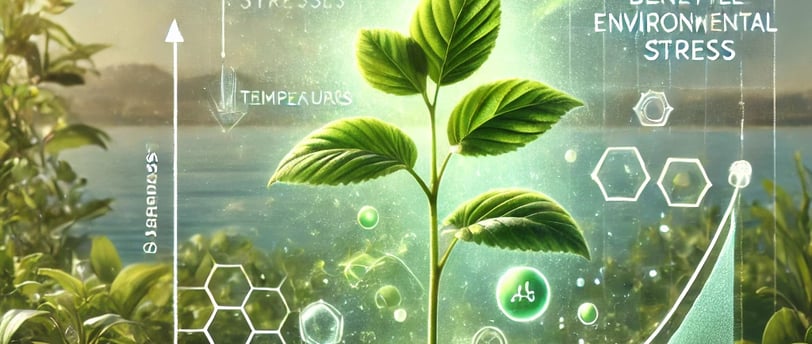Hormesis in Plants How Stressors Like Temperature and Pollutants Shape Growth
Mild environmental stressors like temperature fluctuations and low-dose pollutants can stimulate plant growth and resilience through a phenomenon known as hormesis. This article explores how plants respond to these stressors, highlighting scientific findings on dose-response relationships and the potential benefits of controlled environmental challenges.
AGRICULTURE
Maham Nasir, Department of Botany, UAF. Dr Rizwan Maqbool, Associate Professor, Department of Agronomy, UAF
1/14/20252 min read


Although evidence of hormesis has been observed since the late 1880s in plants. Hormesis is induced in plants across multiple levels of organization cellular, organ, organismal and community by diverse substances including environmental pollutants, chemicals and factors such as nitrogen deposition, ground-level ozone, sulfur dioxide and radiation.
Temperature emerges as a pivotal factor in the biology of global change
With the apparent increase in average global surface temperature over recent decades, temperature emerges as a pivotal factor in the biology of global change. Understanding how plants react to temperature across a spectrum of responses is crucial. Air temperature is very important in finding the health of organisms and living organisms have developed advanced biological mechanisms to regulate their body temperature. This applies even to immobile animals, which possess such regulatory systems.
The impact of air temperature on plants
The impact of air temperature on plants has been extensively studied in the literature. Several tree species respond favorably to higher temperatures. Additionally, a recent meta-analysis indicates that woody plants' growth, productivity and general health were all improved by temperature increases of 0.3 to 10C.
Dose-response relationships in plants
Exploring dose-response relationships would offer insights into this question. However, compared to studies involving chemical agents, conducting dose-response experiments with environmental factors such as ozone, temperature and carbon dioxide poses technical challenges. There is often a shortage of exposure levels and limited spacing between them in these experiments. In this study, we conduct a literature review and present the initial comprehensive evidence of hormetic responses in plants induced by temperature.
Hormetic effects on leaf yield in different temperate
Since the 1960s, researchers have observed hormetic effects on leaf yield in cool temperate, warm temperate and winter annuals in response to soil temperature. The most significant stimulating responses were noted within the temperature range of 12.55–27.54°C. Extensive experiments were conducted to assess the impact of sulfur dioxide and ozone on various oat varieties. This study examined how oat plants responded to four temperature ranges (18 to 30 degrees Celsius), varying relative humidities and sulfur dioxide concentrations. The results indicate that hormesis might have influenced both the root and shoot dry weights of oat plants across four exposure events, each lasting three hours during every trial. Similarly, the number of Phaseolus vulgaris L. pods exposed to different air temperatures 82 days after planting showed a dose-response pattern reminiscent of hormesis.
Hormetic effects with respect to physiological and biological aspects
Hormetic effects have been observed in various physiological and biological aspects of numerous plants. For instance, in a study involving Quercus myrsinaefolia Blume, a temperate evergreen tree species, researchers examined the gas exchange responses to growth temperatures. This study identified inverse dose-response relationships for parameters such as net photosynthetic rate, gross photosynthetic rate, carboxylation and dark respiration. Similar inverse dose-response correlations between net photosynthesis mean monthly temperature have been documented in multiple taxa across different plant families.
The biphasic dose-response is a fundamental feature of hormesis
The biphasic reactions of cell to various substances are documented in thousands of published studies. Numerous meta-analyses, listing multiple instances of these hormetic dose-response curves. While many hazardous substances indeed cause a biphasic dose-response in cells and organisms, not all do. Examples of factors that exhibit a biphasic dose-response include various chemicals, heat, radiation, exercise and energy intake, as demonstrated by research conducted in the lab over a decade ago.
Studies on hormesis often observe that animals or cells can be safeguarded against various stresses by low doses of a single hormetic agent. For example, mild heat stress can shield cells from oxidative stress and toxins like cyanide. Recent research suggests that many phytochemicals could also provide health benefits through hormesis mechanisms, where a phytochemical activates one or more adaptive cellular stress response pathways.
